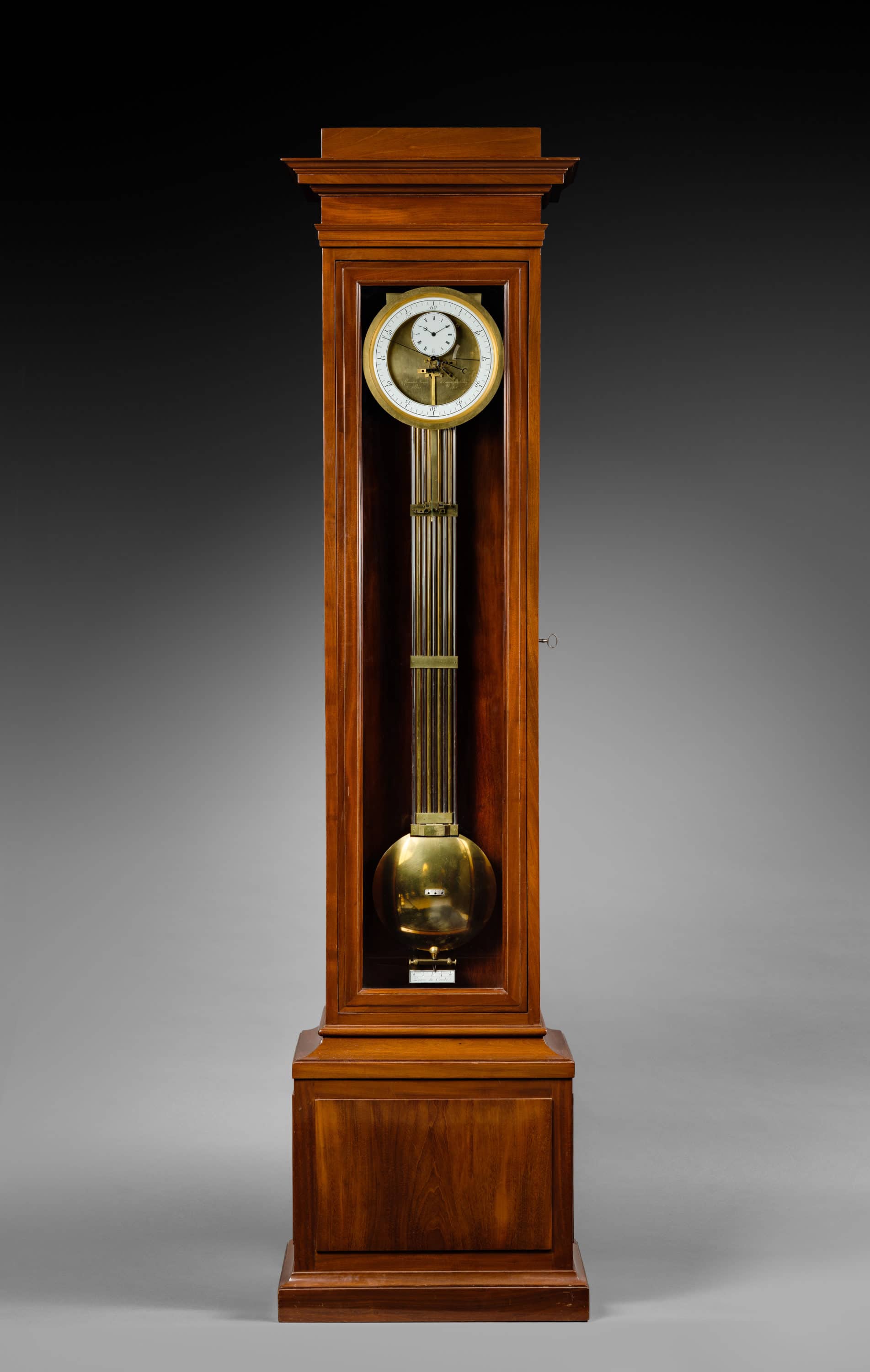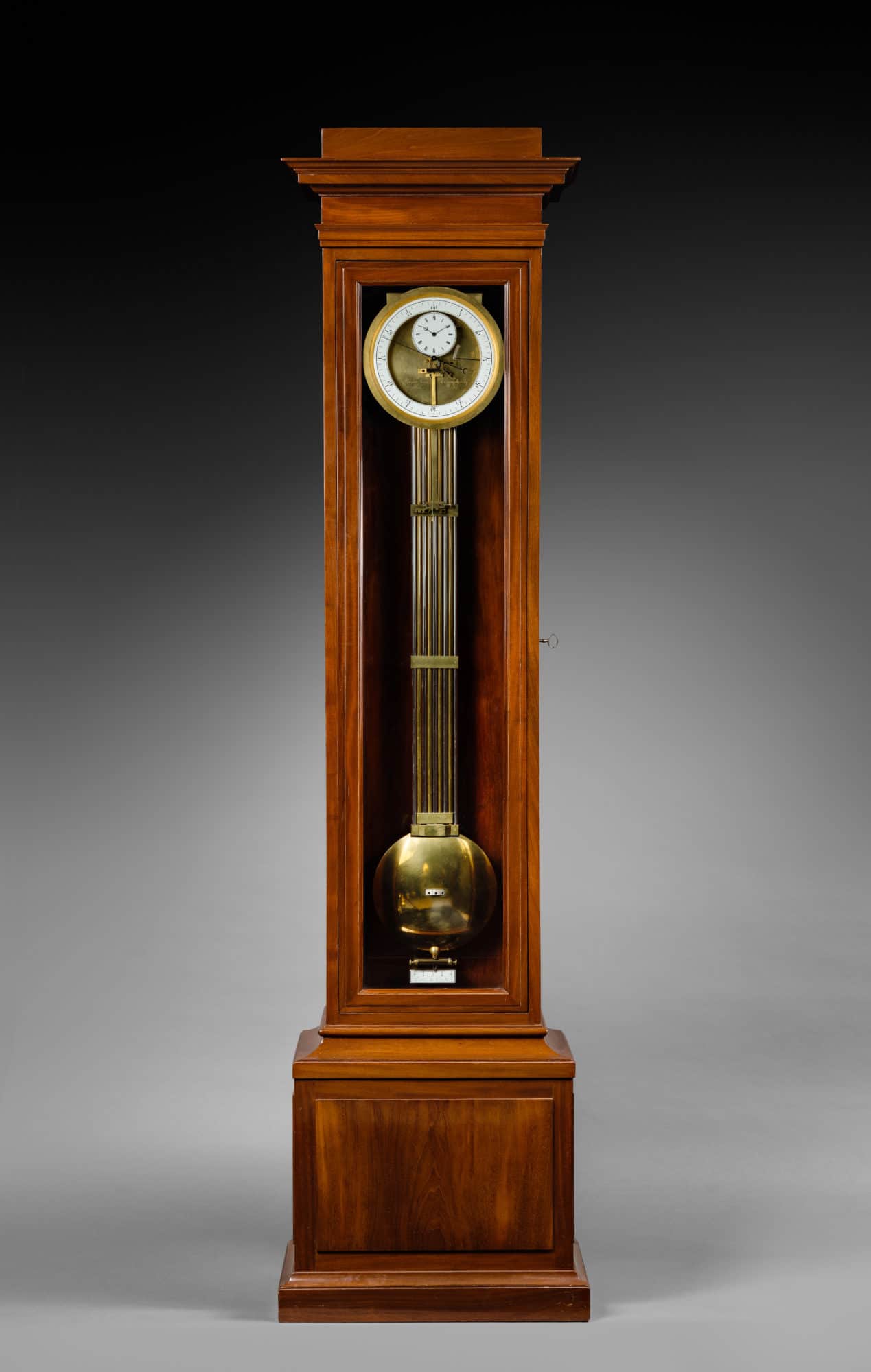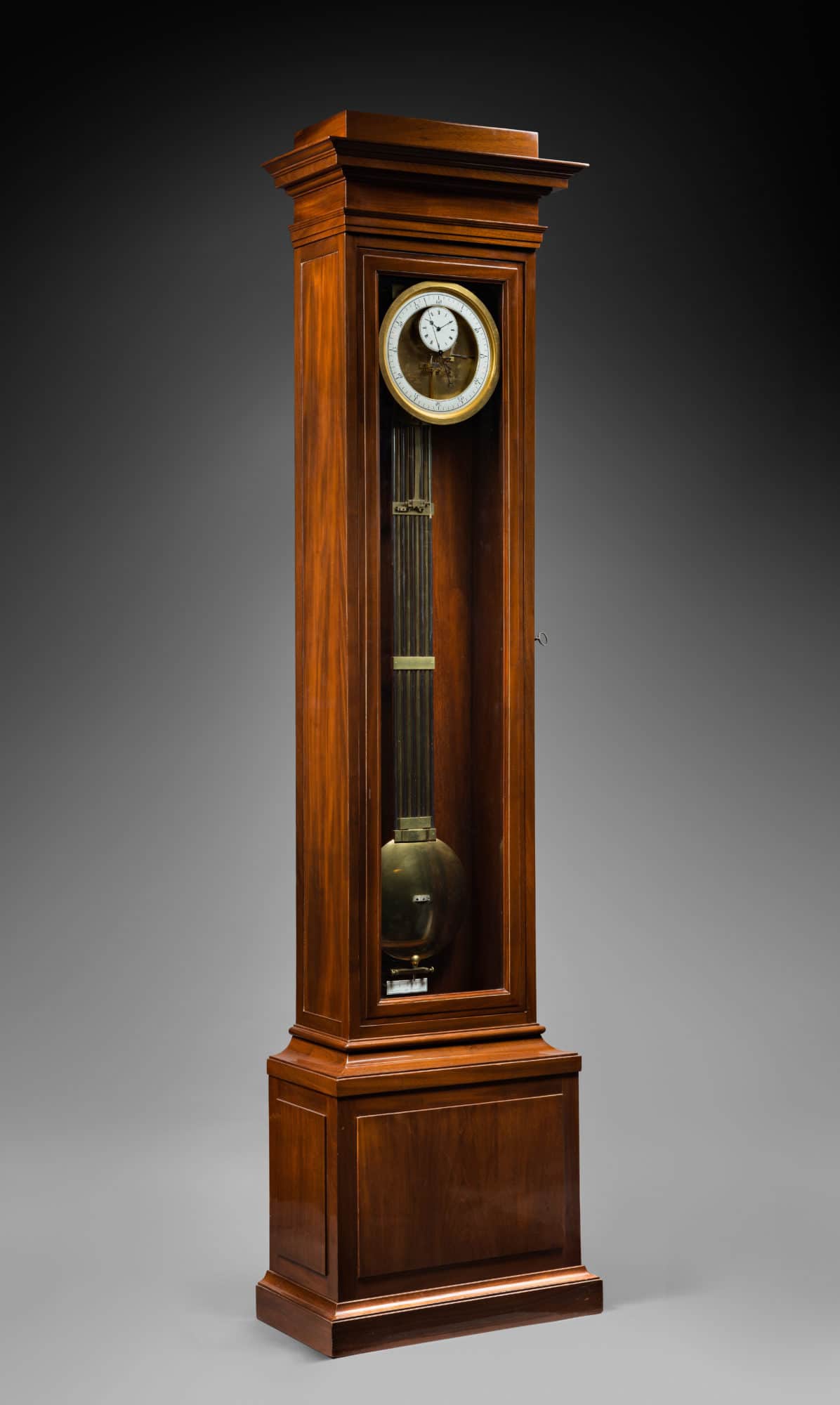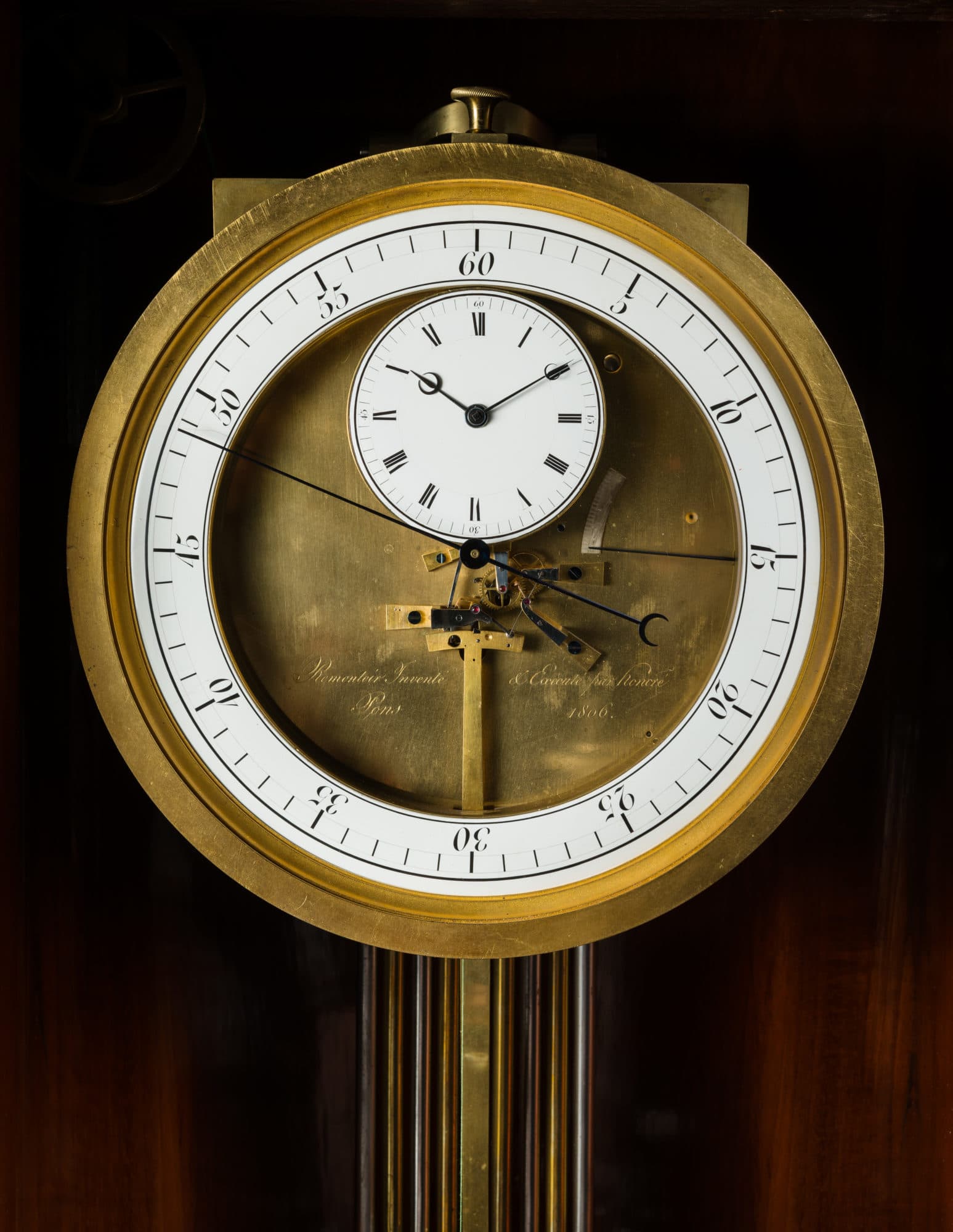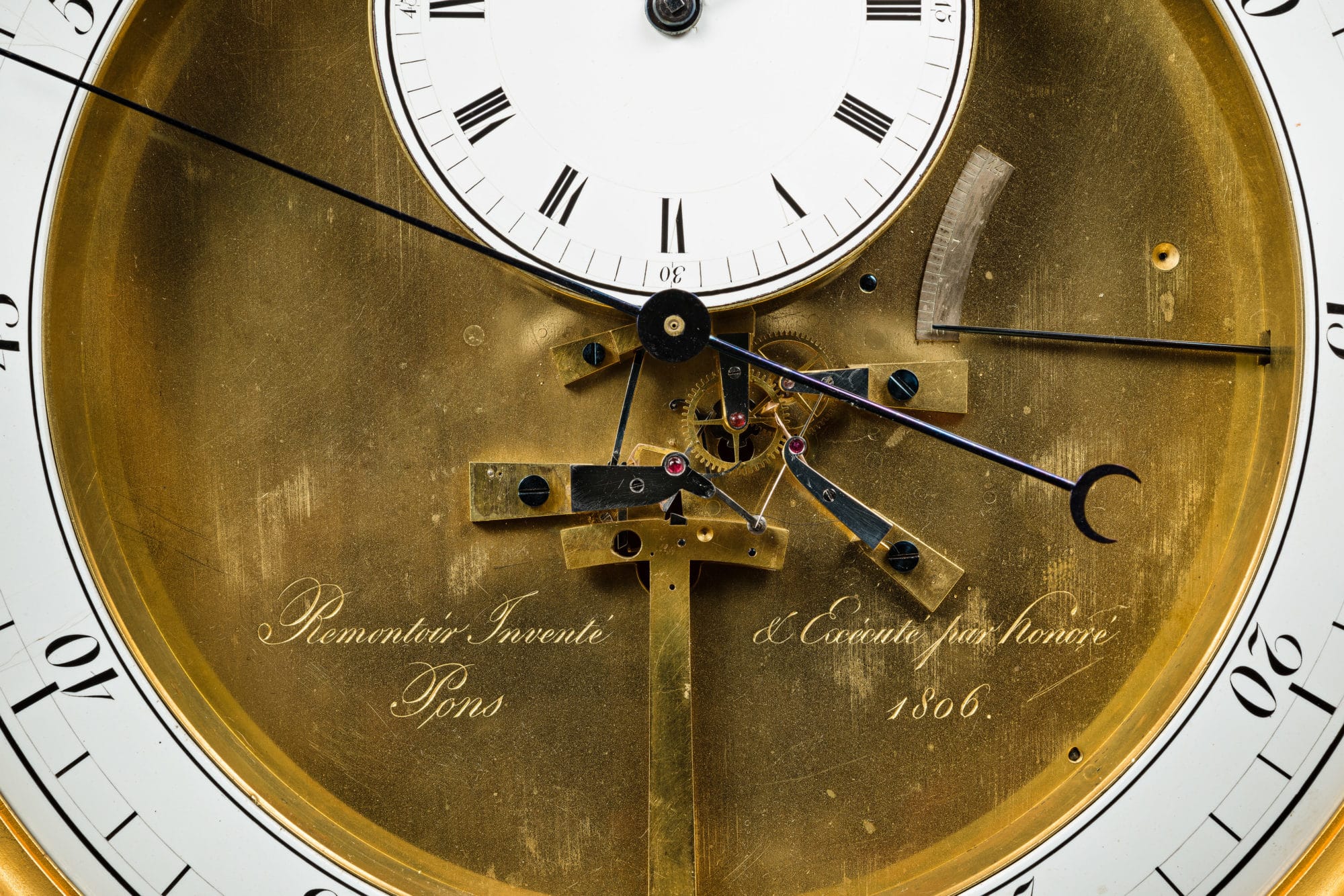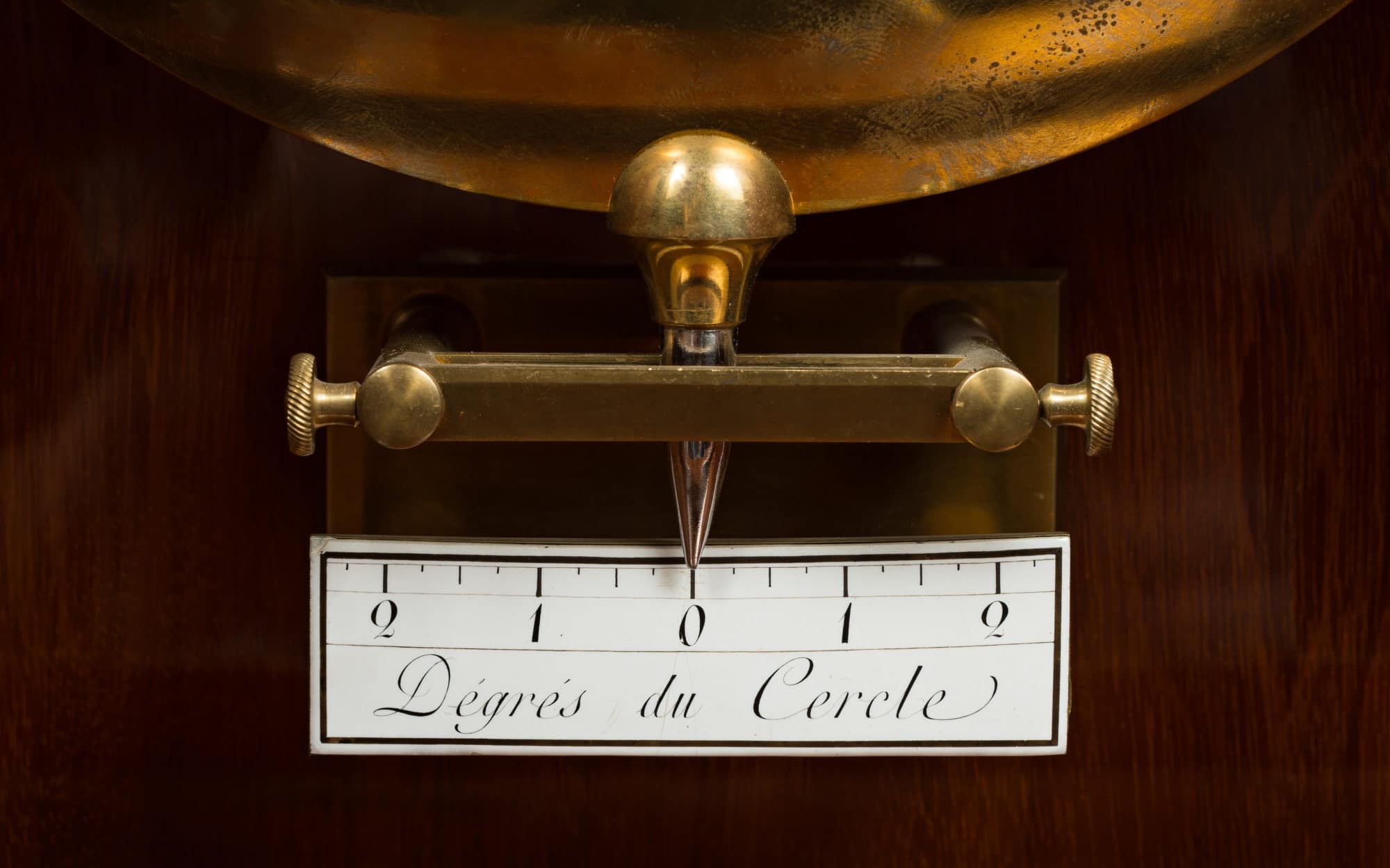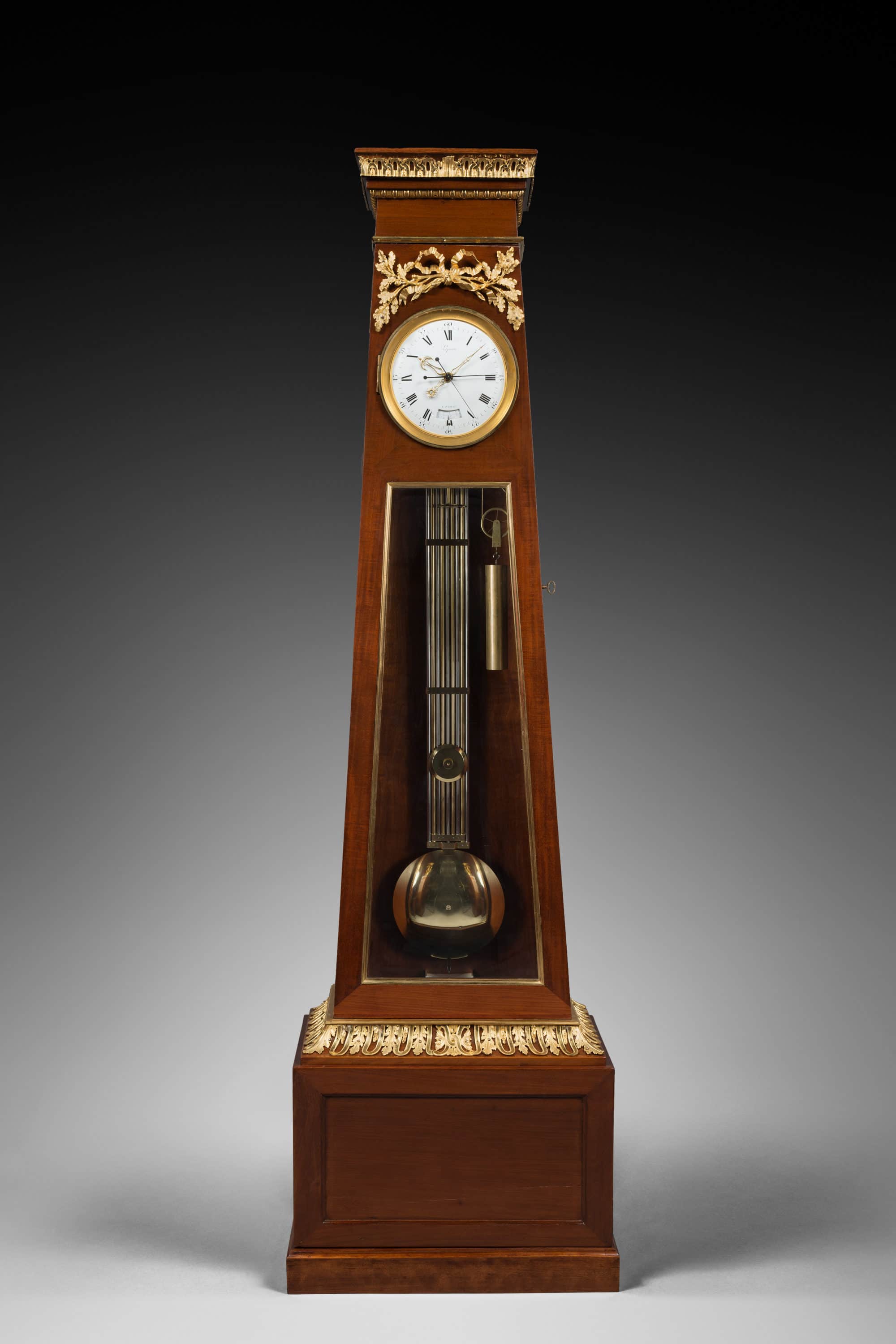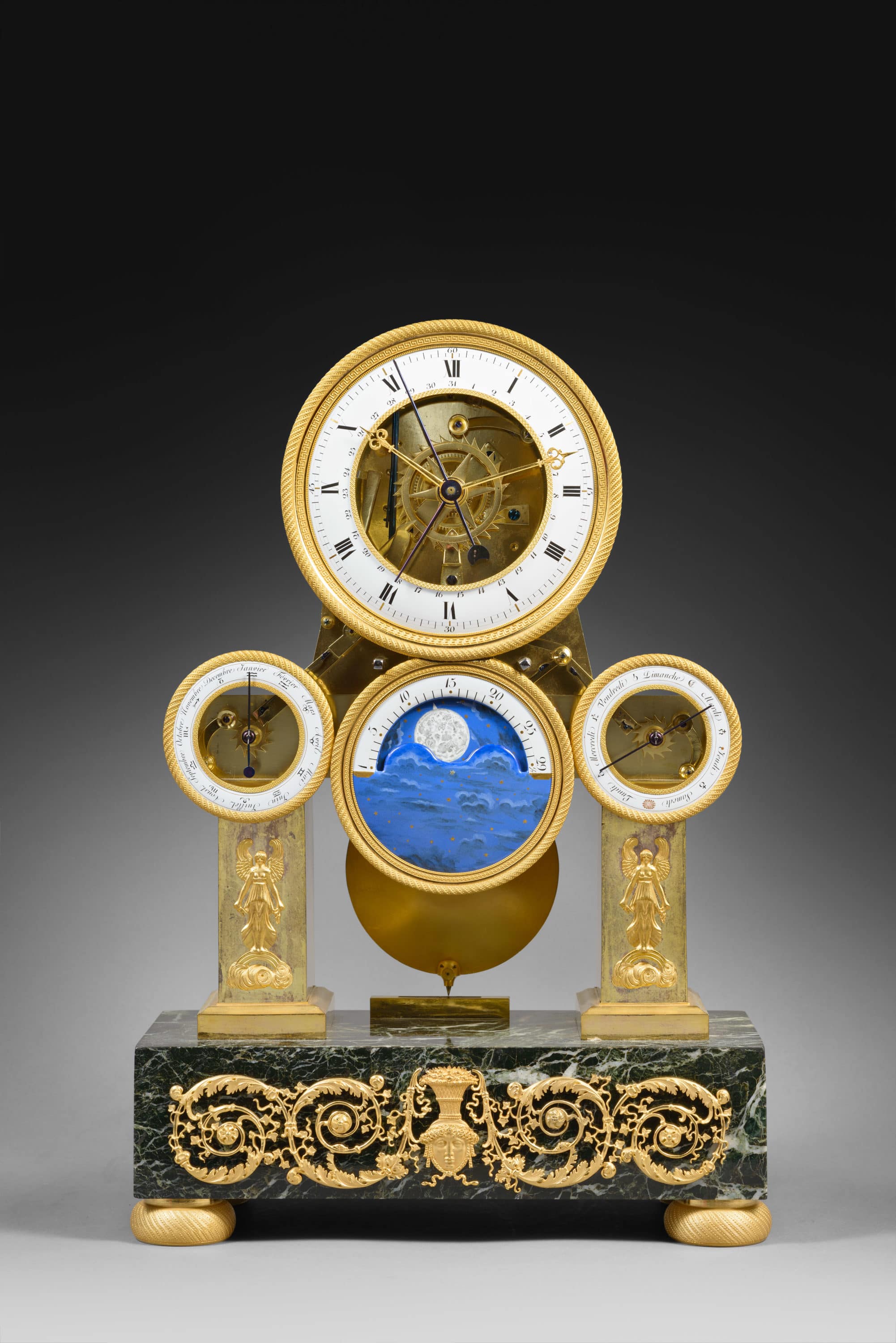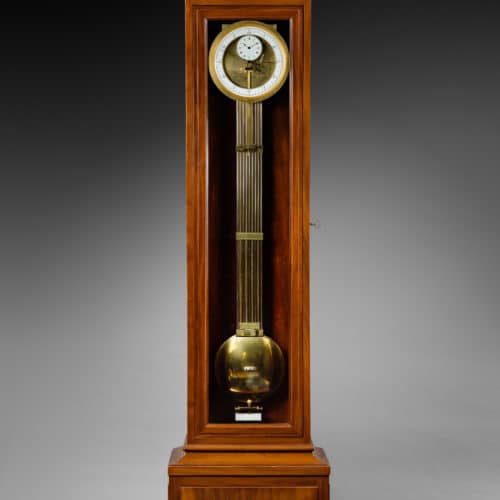Exceptional Mahogany and Mahogany Veneer Regulator with Constant Force Escapement
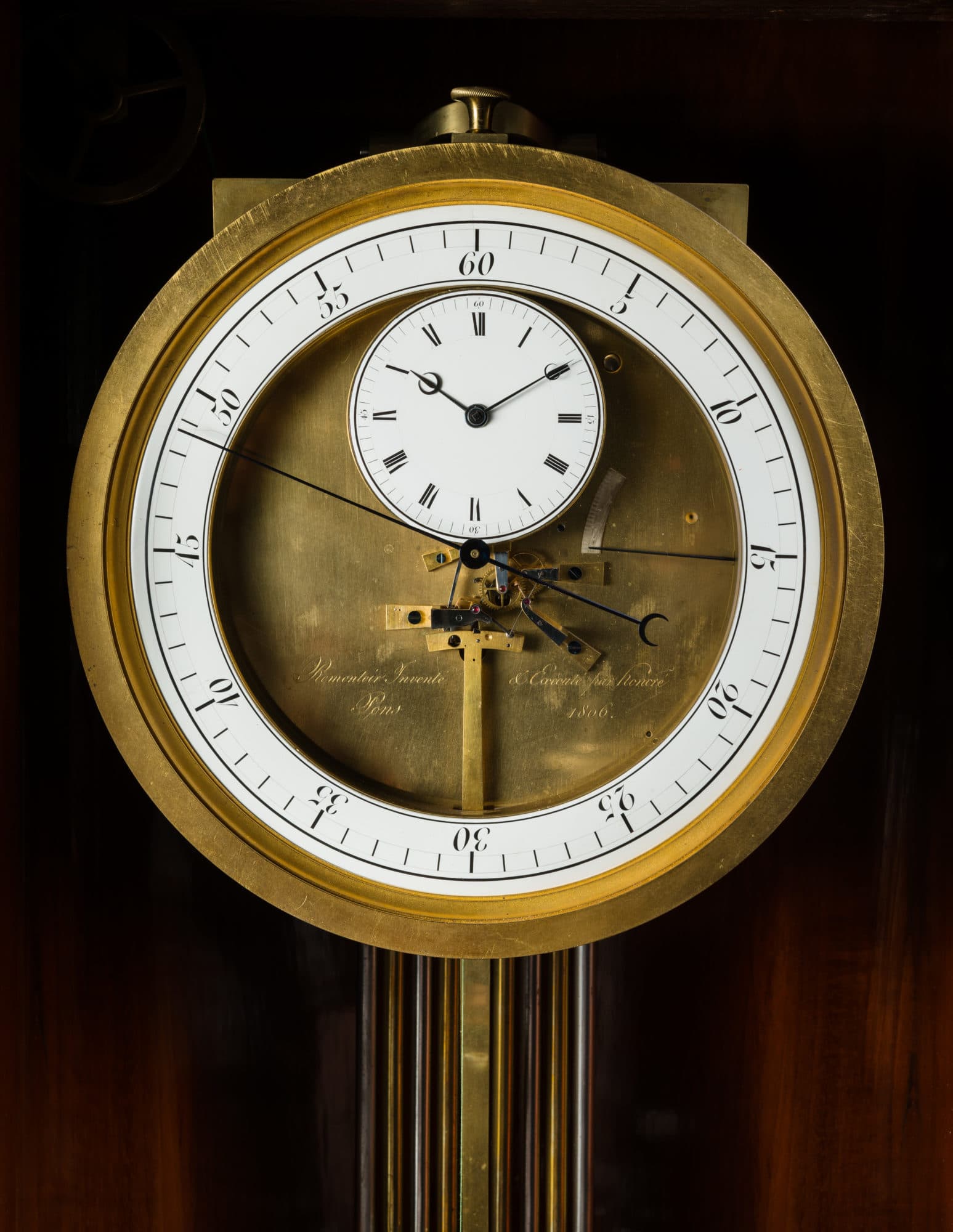
Enamel Dial by Etienne Gobin, known as Dubuisson
Mahogany Case Attributed to Ferdinand Schwerdfeger
Paris, Empire period, plate signed and dated 1806
The enamel ring dial, with moulded bezel, indicates the five-second intervals with two-second graduations, by means of a central seconds hand; within this main ring dial another subsidiary dial indicates the Roman numeral hours and the fifteen-minute graduations by means of two blued steel hands; its copper or gilt bronze back plate bears the inscription “Remontoir Inventé & Exécuté par Honoré Pons 1806”. A crescent-shaped aperture in the plate is graduated from 0 to 14, indicating the 14-day power reserve. On the reverse, the dials bear the mark “Dub”, which is the abbreviated signature of Etienne Gobin, known as Dubuisson. A colleague and the principal rival of master enameller Joseph Coteau, Dubuisson was one of the most famous enamellers of his day. The movement is driven by a small weight weighing only a few grams. It serves as the driving force for the bimetallic gridiron pendulum with knife-edge suspension. An index on the bob indicates the “degrees of the circle” (les degrés du cercle) on an enamel plaque graduated twice from 0 to 2. The magnificent neoclassical mahogany and mahogany-veneered case features a protruding moulded cornice surmounted by a rectangular entablature that rests on an oblong trunk with a glazed door. The solid plinth with a protruding panel is set upon a quadrangular moulded base. Both the architectural design of this regulator and the excellent quality of its assembly and mahogany veneering strongly support its attribution to Ferdinand Schwerdfeger, a former cabinetmaker to Queen Marie-Antoinette who specialised in making clock and regulator cases during the Empire period.
Discover our entire collection of antique regulator clocks for sale online or at the gallery.
The present regulator, an exceptional example of the remarkable movements produced by the inventive Honoré Pons, may be considered a true horological prototype. Pons was a brilliant clockmaker, a student of the Lepautes and Janvier, who worked closely with Berthoud and Lépine; he is without a doubt one of the finest horologists of his time. He was especially interested in escapements and once constructed a series of six escapements for demonstration. These pedagogical masterpieces, which Baron Armand-Pierre Seguier (1803-1876) presented to the Ecole d’Horlogerie de Paris in 1852, are today in the Musée des Techniques of the Conservatoire National des Arts et Métiers in Paris. Pons registered many patents for his inventions and improvements. He also took part in several important exhibitions where he was awarded numerous prizes, including silver medals at the Paris Exhibitions of 1819 and 1823, and gold medals at those of 1827, 1834, 1839 and 1844.
The present regulator bears witness to Pons’s interest in precision horology, an interest he shared with his mentor Antide Janvier (1751-1835). Its date, 1806, coincides with one of the clockmaker’s most prolific periods. That same year several of his pieces were particularly praised at the Exposition des Produits de l’Industrie française:
“M. Pons, rue de la Huchette, n°16, in Paris
Presented several clocks, including one whose composition pendulum vibrates every half-second, with constant arcs, with an added detached escapement mechanism.
All the clocks presented by Monsieur Pons are intelligently constructed and perfectly executed; the regularity of their rate has been confirmed by astronomical observation.
The jury awards a 1st class silver medal to Mr. Pons”.
(1806 Exhibition, Rapport du jury sur les produits de l’industrie française présenté à S.E.M de Champagny, Ministre de l’intérieur, Imprimerie impériale, Paris, 1806, n° 443).
Pierre-Honoré-César Pons (1773 - 1851)
Born in late 1773 in Paris’s rue Mouffetard, Honoré Pons showed an interest in science at a very early age. He was particularly fascinated by time measurement, which perhaps shows he was predestined to become a horologist. In 1789, after a course of serious study with the Jesuits in the rue Mouffetard, he began his training with the most brilliant horologist of the day, Antide Janvier. However, his studies were disrupted by the political and social unrest of the period; the Revolution soon broke out, with the result that craftsmen’s guilds became a thing of the past. However, Pons remained in contact with Janvier, who recommended him to the Lepautes; in 1798, he began working in their workshop – one of the most prestigious – as a clockmaker. He finished his training there and soon became interested in precision horology. In 1803 he opened his own workshop in the rue de la Huchette, near the Place Saint-Michel. Despite a promising start, Pons was obliged to continue to act as a supplier for some of his famous colleagues on the other side of the Seine, including Berthoud, Breguet and Lépine. This allowed him to continue working, while still having the leisure to pursue his obsessive quest to perfect time measurement. He invented several escapements and also created machines designed for cutting gear teeth and perfectly polishing pinion leaves. With the support of Ferdinand Berthoud, who was impressed by his inventive genius, Pons presented his Observations sur l’échappement libre to the Academy of Sciences in January 1804. His work was well received; the jury praised him in their report and the Academy congratulated the young horologist.
While Pons showed extraordinary promise during the early years of his career, at the same period the horological production of Saint-Nicolas d’Aliermont, a small city near Dieppe, was undergoing a serious crisis. The city specialised in the production of clock movements “en blanc” which were sent to Paris for finishing. The industry’s collapse was noted in a report which the Prefect Savoye-Rollin sent to the Count de Champagny, Napoleon’s minister in charge of the Fine Arts, Industry, and Commerce. Champagny immediately ordered the Académie des Sciences to find a competent horologist who might be able to revitalise Saint-Nicolas d’Aliermont’s horological industry. The Academy naturally designated Honoré Pons, who, in addition, possessed excellent tools and machinery. Duly contacted, Pons was initially sceptical. To encourage him to accept the mission, the French government offered to purchase his machines at a generous price, with the stipulation that they would be used in Saint-Nicolas’s future workshops. Finally, Pons accepted the offer, left Paris with his eight machines in tow, and upon his arrival, completely reorganised the production process in Saint-Nicolas. By June 1808, less than two years later, Pons had achieved his goal of producing exceptional quality movements. When asked by the Comité des Arts mécaniques to examine a clock movement Pons had presented to the Société des Arts, the famous horologist Breguet wrote:
“I myself have examined, with the greatest attention, the clock movement that Mr. Pons presented to the Société. I additionally asked the opinion of several honest and excellent clockmakers. We have together concluded that if this clockmaker continues to sell movements of the same quality for 40 F (francs), he will have greatly advanced the execution processes of this segment of horology, which must be efficaciously supported if we are to produce good quality clocks.
Mr. Pons’s movement is much superior to others of the same size, which sell for 50 F. It presents the further advantage of having well formed and regular teeth, which is extremely important, and which one unfortunately sees too rarely in serially produced objects. The frame of this clock is remarkably well assembled, the pinions are rounded and the rods well hardened.
It follows from the preceding that Mr. Pons has succeeded in making clock movements that he can deliver for approximately one-fifth less than the current price. They are much better made and of better quality than those that all the factories have produced until the present time. By thus perfecting this art, which has so many potential consumers, Mr. Pons has made himself directly useful to both commerce and the public, and therefore deserves all the encouragement the Société is able to offer.”
Several months later, Honoré Pons was again favourably mentioned the Academy’s traditional report to Napoleon Bonaparte on the progress of science in France:
“A few up-and-coming young people have already distinguished themselves by their remarkable talent. If the excellent art of horology does not succumb to the dangers that threaten it today, these young people will one day take the place of the great horological masters. The most remarkable of these young clockmakers is Mr. Pons. His escapements are very elegant; he loves his art; he is a thinker; his gear and pinion-cutting machine is a work of genius”.
Clearly, the pieces that Pons produced in Saint-Nicolas, then sold in a shop in Paris’s rue de la Barillerie on the île de la Cité, were of very high quality. All the great clockmakers came to make purchases in his Paris shop. Among his products, an unassembled movement called a “mouvement en blanc” or “blanc roulant”, consisted of two plates, the complete motion work, the striking work (without timbre), the barrels and the timing train, with an unfinished escape wheel. The movements, purchased in the rue de la Barillerie, were then finished by Parisian clockmakers who selected the model and escapement toothing, assembled the movement and housed it in a case, thus creating a “pendule de Paris”, or “Paris clock”. Within just a few years, Pons made the Saint-Nicolas d’Aliermont factory the largest French supplier of “blancs roulants”. He was esteemed by his peers and by connoisseurs of fine horology, and in 1839 was awarded the Croix de la Légion d’Honneur by King Louis Philippe. In 1846, at the end of a brilliant career, he sold his firm to Borromée Délépine and retired, living in an elegant Parisian mansion at 20, rue Cassette.
Discover our entire collection of rare clocks on La Pendulerie Paris.
Dubuisson (1731 - after 1820)
Etienne Gobin, known as Dubuisson, was one of the most talented Parisian enamellers of the reign of Louis XVI and the Empire period. Born in Luneville in 1731, he began his career as a painter on porcelain in Strasbourg and Chantilly. He then moved to Paris and worked at the Royal Sèvres porcelain manufactory from 1756 to 1759, specializing in the decoration of watch cases and clock dials. In the 1790s, his workshop is mentioned as being in the rue de la Huchette, then the rue de la Calandre around 1812. He appears to have retired in the early 1820s. He mostly signed his work “Dubuisson” or “Dub”, sometimes “Dubui”. Having worked with the most renowned clockmakers of his time, including Robert Robin, Kinable, and the Lepautes, Dubuisson was the main rival of Joseph Coteau. Specializing in watch cases and enamel dials, he was famous for his exceptional talent and his ability to render detail. His body of work, always of the highest quality, is considerable. To mention only a few of his pieces, some clocks bearing his signature are today in Pavlovsk Palace near Saint Petersburg, in the Louvre Museum in Paris, and in the Royal British Collection.
Ferdinand Schwerdfeger (1734 - 1818)
Ferdinand Schwerdfeger is one of the most important Parisian cabinetmakers of the late 18th century. After becoming a master in May 1786, he opened a workshop in Paris and quickly gained a following. His work, however, remains little known due to his becoming a master shortly before the Revolution, and to the fact that he rarely stamped his work. Among the pieces that may be attributed to him with certitude, one should mention an ensemble delivered to Marie-Antoinette, as well as several regulator and clock cases for some of the finest horologists of the day, including Antide Janvier, Jean-Simon Bourdier and Robert Robin (see M-A Paulin, Schwerdfeger, ébéniste de Marie-Antoinette, in L’Estampille/L’Objet d’art, October 2003).
